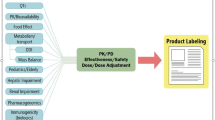Abstract
Objective:This study evaluated the utilisation of human pharmacology studies with biomarkers for either efficacy or safety estimation conducted for new drug applications (NDAs) submitted to the Japanese regulatory authority, the Ministry of Health, Labour and Welfare (MHLW).
Methods: A total of 50 new chemical entities (NCEs) posted on the Websites, which were approved from June 2000 to November 2001, were evaluated by investigating their approval information. The utilisation of human pharmacology studies with biomarkers was evaluated by focusing on the classification referred to biomarkers for either efficacy or safety estimation and timing of studies.
Results: The human pharmacology studies with biomarkers for either efficacy or safety estimation were conducted in 20 compounds classified by utilising measures of either efficacy (17 compounds) or safety (seven compounds). In 4 of 17 NCEs, some of the biomarkers in human pharmacology studies were similar to the clinical endpoints for efficacy assessment in therapeutic exploratory and/or therapeutic confirmatory studies. For safety assessment in therapeutic exploratory and/or therapeutic confirmatory studies, clinical endpoints rather than biomarkers in human pharmacology studies were used in all seven NCEs. The timing of each type of clinical study could only be obtained for 15 NCEs. Of these 15 NCEs, human pharmacology studies with biomarkers for either efficacy or safety estimation were conducted on six compounds. There were only two compounds for which human pharmacology studies with biomarkers for efficacy estimation were conducted before pivotal studies such as a therapeutic exploratory study or a bridging study.
Conclusion: Our survey suggests that with Japanese NDAs, human pharmacology studies with biomarkers for either efficacy or safety estimation do not play a key role in accelerating drug development and maximising the knowledge gained from confirmatory trials. The relationship between a biomarker and a clinical endpoint should be investigated appropriately for accelerating drug development. We think that the utilisation of human pharmacology studies with biomarkers for either efficacy or safety estimation in the regulatory review process for NDAs should be encouraged with the advancements of drug evaluation research using an appropriate biomarker based on clinical pharmacology.








Similar content being viewed by others
References
International Conference on Harmonisation (ICH) Harmonised Tripartite Guideline (step 4). Topic E8: General Considerations for Clinical Trials. Geneva: ICH-secretariat, 1997
Biomarkers Definitions Working Group. Biomarkers and surrogate endpoints. Preferred definitions and conceptual framework. Clin Pharmacol Ther 2001; 69: 89–95
Lesko LJ, Atkinson Jr AJ. Use of biomarkers and surrogate endpoints in drug development and regulatory decision making, criteria, validation, strategies. Ann Rev Pharmacol Toxicol 2001; 41: 347–66
Pharmaceuticals and Medical Devices Agency (PMDA). Information on New Drug Approvals [in Japanese]. Available from URL: http://www.info.pmda.go.jp/shinyaku/shinyaku_index.html [Accessed 2002 Aug 1]
Japan Pharmacists Education Center (JPEC). Information on New Drug Approvals [in Japanese]. Available from URL: http://www.jpec.or.jp/contents/c01/shinyaku.html [Accessed 2002 Aug 1]
International Conference on Harmonisation (ICH) Harmonised Tripartite Guideline (step 4). Topic E5: Ethnic factors in the acceptability of foreign clinical data. Geneva: ICH-secretariat, 1998
Pharmaceutical and Medical Safety Bureau (PMSB) Notification No. 739. Tokyo: Ministry of Health and Welfare (MHW), 1998 Aug 11
National Institute of Health Sciences (NIHS) Review report No. 2711 [in Japanese]. Tokyo: 2000 Jul 24
National Institute of Health Sciences (NIHS) Review report No. 2677 [in Japanese]. Tokyo, 2000 Jul 17
Lesko LJ, Rowland M, Peck CC, et al. Optimizing the science of drug development, opportunities for better candidate selection and accelerated evaluation in humans. J Clin Pharmacol 2000; 40: 803–14
Heath G, Colburn WA. An evolution of drug development and clinical pharmacology during the 20th century. J Clin Pharmacol 2000; 40: 918–29
Sycha T, Gustorff B, Lehr S, et al. A simple pain model for the evaluation of analgesic effects of NSAIDs in healthy subjects. Br J Clin Pharmacol 2003; 56: 165–72
Pohle T, Domschke W. Gastric function measurements in drug development. Br J Clin Pharmacol 2003; 56: 156–64
de Visser SJ, van der Post JP, de Waal PP, et al. Biomarkers for the effects of benzodiazepines in healthy volunteers. Br J Clin Pharmacol 2003; 55: 39–50
Rolan P, Atkinson AJ, Lesko LJ, et al. Use of biomarkers from drug discovery through clinical practice, report of the Ninth European Federation of Pharmaceutical Sciences Conference on Optimizing Drug Development. Clin Pharmacol Ther 2003; 73: 284–91
International Conference on Harmonisation (ICH) Harmonised Tripartite Guideline (step 4). Topic E6: guideline for good clinical practice. Geneva: ICH-secretariat, 1996
Sweatman J. Good clinical practice, a nuisance, a help or a necessity for clinical pharmacology? Br J Clin Pharmacol 2003; 55: 1–5
Peck CC, Rubin DB, Scheiner LB. Hypothesis, a single clinical trial plus causal evidence of effectiveness is sufficient for drug approval. Clin Pharmacol Ther 2003; 73: 481–90
Acknowledgements
The opinions and views expressed in this article are those of the authors and not of the Ministry of Health, Labour and Welfare in Japan. No sources of funding were used to assist in the preparation of this manuscript. The authors have no conflicts of interest that are directly relevant to the content of this manuscript.
Author information
Authors and Affiliations
Corresponding author
Rights and permissions
About this article
Cite this article
Kodama, Y., Saito, K., Ono, S. et al. Utilisation of Human Pharmacology Studies with Biomarkers for New Drug Applications in Japan. Drugs in R D 6, 21–34 (2005). https://doi.org/10.2165/00126839-200506010-00003
Published:
Issue Date:
DOI: https://doi.org/10.2165/00126839-200506010-00003




